How to Create a Multiaxis Parallel to Multiple Curves Feature
Introduction
This tutorial explains how to create a Multiaxis feature with the Parallel to Multiple Curves toolpath. This toolpath creates cuts that are parallel to the selected edge curves and applied to the selected drive surfaces.
Example File
The BobCAD part file for this tutorial is available for download at: http://bobcad.com/helpfiles. If you are connected to the Internet, you can click the link provided to download and save the Parallel to Multiple Curves Example 1 BBCD.zip file. After extracting the zip file, you can open the file to follow along with this example. In the example file provided, the stock and Machine Setup are already defined for the part. The part is simulated using the BC Table-Table machine.
In this example, you learn how to apply a toolpath using multiple edge curves to finish the bottom of multiple pockets with angled walls. You learn how to change the default tool orientation using a tilting strategy with some special notes on handling a tool axis that is parallel to the surface normal of the selected drive surfaces.
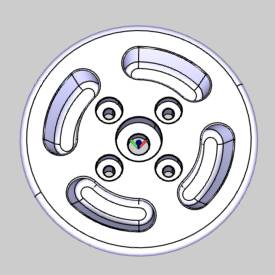
Part 1) Add the Feature
-
In the CAM Tree Manager, right-click
 Machine
Setup and click Mill Multiaxis.
Machine
Setup and click Mill Multiaxis. -
In the Multiaxis Wizard, select Surface and click Parallel to Multiple Curves.
-
Click Next>> to go to the Posting settings.
Part 2) Define the Posting Parameters
-
The Work Offset # is automatically set to the value defined in the Machine Setup.
You can change the value here to update the Work Offset # for the feature. -
Click Next>> to go to the Multiaxis Posting settings.
Part 3) Define the Multiaxis Posting Parameters
-
Notice, at the top of the dialog box, that the Use Machine Settings check box is selected.
This means that the Multiaxis Posting parameters for the feature use the same parameters as the machine that is selected in Current Settings.
You can clear the Use Machine Settings check box to define the Multiaxis Posting parameters of the feature separately from the current machine settings.
An example usage is explained later. -
Click Next>> to go to the Tool settings.
Part 4) Define the Tool Parameters
-
In the Tool Data group, set the Diameter to 0.500, and the Corner Radius to 0.250.
-
To assign a tool holder, click Assign Tool Holder.
In the Milling Tool Holder Library, in the CAT 40 Holder list, click 0.5 inch I.D. Arbor CAT 40.
Click OK. -
Click Next>> to go to the Parameters.
Part 5) Select Geometry
-
To define the curves that are used to create the parallel cuts, in the Pattern group of the Surface Paths tab, click Edge Curves.
-
In the Quick Selection group, of the Home ribbon, click
 Pick By Layer.
Pick By Layer.
In the Select Layer dialog box, click Edge Curves and click OK.
(As shown in the second image, you can press T to make the part model transparent thus making it easier to see the selected geometry.)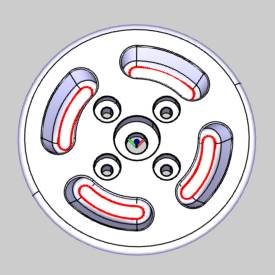
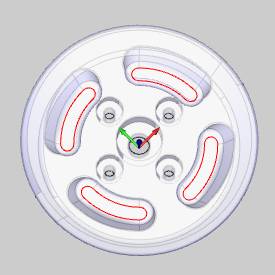
-
To confirm the selection, click
 .
.
Tip: To accomplish the same Edge Curve geometry selections as shown previously without creating extra geometry, point to each surface edge, right-click, and select Constant Z.
-
To define the surfaces to machine, click Drive Surfaces.
Select the bottom of each pocket as shown next.
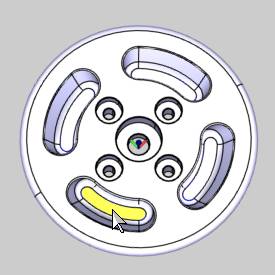
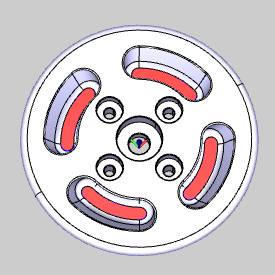
-
To confirm the selection, click
 .
.
The geometry selections are complete.
Part 6) Define the Parameters
-
In the Area group, next to Type, select Determined By Number of Cuts.
In the Number of Cuts box, confirm the default value of 1. -
In the Sorting group, next to Cutting Method, confirm the setting is One Way.
-
At the top of the dialog box, click Link.
Click Retracts. -
In the Clearance Area group, confirm that the Height is set to 2.00.
This value is automatically set using the value defined in the Machine Setup. This value is only read from the Machine Setup when the feature is created. Existing features don't update if you change the Clearance value in the Machine Setup. You can change the Clearance value for Multiaxis features at any time in the Retracts dialog box.
Click OK. -
To calculate the toolpath, at the bottom of the Multiaxis Wizard, click Compute.
The result is shown next.
(To make the part transparent, press T. This makes the toolpath easier to view.)
Tip: To make
a toolpath easier to view, click the icon (or the name) of the operation
in the CAM Tree. This highlights the toolpath display in the graphics
area. For this example, in the CAM Tree, click ![]() Multiaxis.
Multiaxis.
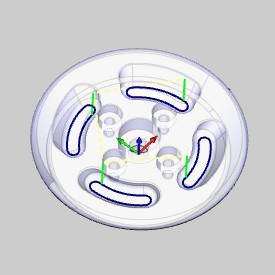
The toolpath shows that the entry into each pocket is normal to the surface, which in this case, is parallel to the Z-axis.
The next step is to edit the feature and add a tilt angle so the tool avoids gouging the walls.
Part 7) Edit the Feature and Tool Axis Control
When you computed the toolpath, the ![]() Multiaxis feature
was added to the CAM
Tree.
Multiaxis feature
was added to the CAM
Tree.
-
To edit the feature, right-click
 FeatureMultiaxis, and click Edit.
FeatureMultiaxis, and click Edit. -
On the left side of the dialog box, click Parameters.
-
At the top of the dialog box, click Tool Axis Control.
-
Next to Tool Axis Will, select the tilting strategy, Tilted with the Angle.
In the Tilt Angle box, type 30.50.
Confirm the tilt axis is set to Z-axis.
Because the surface normal direction and the selected tilt axis are parallel, the defined tilt angle creates a condition where the defined tool axis crosses the tilt axis. (If you computed the toolpath now, there would be no change to the toolpath.)
To handle the tool axis crossing the tilt
axis, select the ![]() Tool Axis Crosses Tilt Axis check
box.
Tool Axis Crosses Tilt Axis check
box.
-
To apply the changes, click Compute.
The result is shown next.
You can see the change in the entry/plunge move into each pocket in the toolpath display (green).
You can also see that the toolpath moved from the exact edge curve towards the inside of the part because of the new tool orientation.

Part 8) Simulation
The next step is to simulate the program to look for any necessary changes.
- In the quick access toolbar, of the CAM Tree Manager, click
 .
.
For help with simulation, view Getting Started with Simulation.
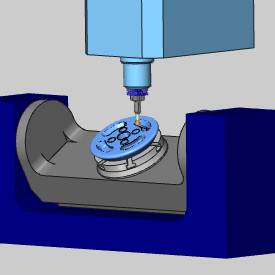
-
To close simulation, click
 Exit Simulation.
Exit Simulation.
Adjust the Machine Table Rotation
When you simulate the program, the machine table is sometimes rotated in a way that doesn't allow you to view the part without rotating the view of the machine. You can change the Angle Pair settings for the feature to modify the table rotation used in simulation and in the posted code.
- To edit the feature, in the CAM
Tree, right click
 FeatureMultiaxis,
and click Edit.
FeatureMultiaxis,
and click Edit. - Click the
Multiaxis Posting icon in the tree.
- Clear the Use
Machine Settings check box.
- In the Angle
Pair group, next to Use,
select Other Solution.
When you simulate the program again, you can now view the part being cut from the opposite side of the machine.
The table is rotated to use the other solution to the rotation angles of the primary and secondary rotary axes (angle pair). This changes the posted output of the program as well as the simulation.
Tip: You don't have to compute the toolpath to update this setting for simulation, but you must Post the program to update the code if has already been posted.
This concludes the tutorial.
